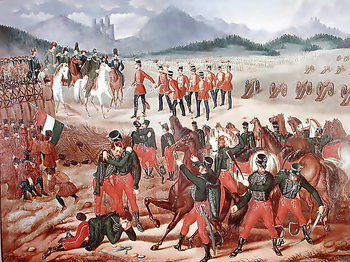
Surrender at Világos
Encyclopedia

Hungarian Revolution of 1848
The Hungarian Revolution of 1848 was one of many of the European Revolutions of 1848 and closely linked to other revolutions of 1848 in the Habsburg areas...
. After it, Julius Jacob von Haynau
Julius Jacob von Haynau
Julius Jacob von Haynau was an Austrian general.The illegitimate son of the landgrave of Hesse-Kassel, William I and Rebecca Richter, a Jewish woman, he entered the Austrian army as an infantry officer in 1801 and saw much service in the Napoleonic wars...
became the regent
Regent
A regent, from the Latin regens "one who reigns", is a person selected to act as head of state because the ruler is a minor, not present, or debilitated. Currently there are only two ruling Regencies in the world, sovereign Liechtenstein and the Malaysian constitutive state of Terengganu...
of Hungary and took bloody reprisals against Hungary. Hungarian General Artúr Görgey
Artúr Görgey
----Artúr Görgey de Görgő et Toporcz was a Hungarian military leader.He was born at Toporz in Upper Hungary of a Hungarian noble family of originally Zipser German descent who immigrated to Upper Hungary during the reign of king Géza II . During the reformation they were converted to Protestantism...
attended to surrender to the Russian
Russian Empire
The Russian Empire was a state that existed from 1721 until the Russian Revolution of 1917. It was the successor to the Tsardom of Russia and the predecessor of the Soviet Union...
army.
Pretext
After the Russians intervened in the conflict, it was only a matter of time before the Hungarians would be defeated, because the Russians had far greater military strength. The deciding point came at the Battle of TemesvárBattle of Temesvár
The Battle of Temesvár was a battle in the Hungarian Revolution of 1848, fought on 9 August 1849 between the Austrian Empire and Hungarian Revolutionary Army supplemented by Polish volunteers. The Austrians were led by Julius Jacob von Haynau, while the Hungarians were led by Józef Bem who...
, which after there were two ways for the Hungarians: Surrender or be annihilated. Görgey received an offer from Russian General Chrurloff on 21 July. Cavalry Captain Katlaroff and Earl Rüdiger delivered the offer to Görgey, who was at Rimaszombat (now Rimavská Sobota
Rimavská Sobota
Rimavská Sobota is a town in southern Slovakia, in the Banská Bystrica Region, on the Rimava river. It has 24,374 inhabitants . The town is a historical capital of the Gömör-Kishont county .-Geography:...
, Slovakia
Slovakia
The Slovak Republic is a landlocked state in Central Europe. It has a population of over five million and an area of about . Slovakia is bordered by the Czech Republic and Austria to the west, Poland to the north, Ukraine to the east and Hungary to the south...
), giving the Hungarian officers and men total freedom.
László Batthyány and another officer delivered Görgey's response to Chrurloff, in which he demanded that all Hungarians would get freedom, not only those who had served in the conflict. He also demanded that he would accept one of the Russian princes to wear the Holy Crown of Hungary (Holy Crown of Saint Stephen).
Surrender
The Hungarian Army surrendered to Russian General Rüdiger on 13 August 1849. At Bohus Castle they signed the document of surrender. Görgey tried to show by the terms of the surrender that Hungary had not been defeated by Austria.Aftermath
After the surrender, the AustriansAustrian Empire
The Austrian Empire was a modern era successor empire, which was centered on what is today's Austria and which officially lasted from 1804 to 1867. It was followed by the Empire of Austria-Hungary, whose proclamation was a diplomatic move that elevated Hungary's status within the Austrian Empire...
made reprisals against Hungary. They sentenced hundreds of soldiers and civilians to death, and imprisoned even more. Prisoners were conscripted to into the Austrian Army.
On 6 October 1849 at Arad (now Arad, Romania
Arad, Romania
Arad is the capital city of Arad County, in western Romania, in the Crişana region, on the river Mureş.An important industrial center and transportation hub, Arad is also the seat of a Romanian Orthodox archbishop and features two universities, a Romanian Orthodox theological seminary, a training...
), the Austrians executed twelve Hungarian generals and one colonel, who are known as the 13 Martyrs of Arad
The 13 Martyrs of Arad
The 13 Martyrs of Arad were the thirteen Hungarian rebel honvéd generals who were executed on October 6, 1849 in the city of Arad, Kingdom of Hungary , after the Hungarian Revolution was ended by troops of the Austrian Empire and Imperial Russia, who reestablished Habsburg rule over the area...
. The same day they executed Lajos Batthyány
Lajos Batthyány
Count Lajos Batthyány de Németújvár was the first Prime Minister of Hungary. He was born in Pressburg on 10 February 1807, and was executed by firing squad in Pest on 6 October 1849, the same day as the 13 Martyrs of Arad.-Career:His father was Count József Sándor Batthyány , his mother Borbála...
, the first Hungarian Prime Minister, by shooting him in the head.

